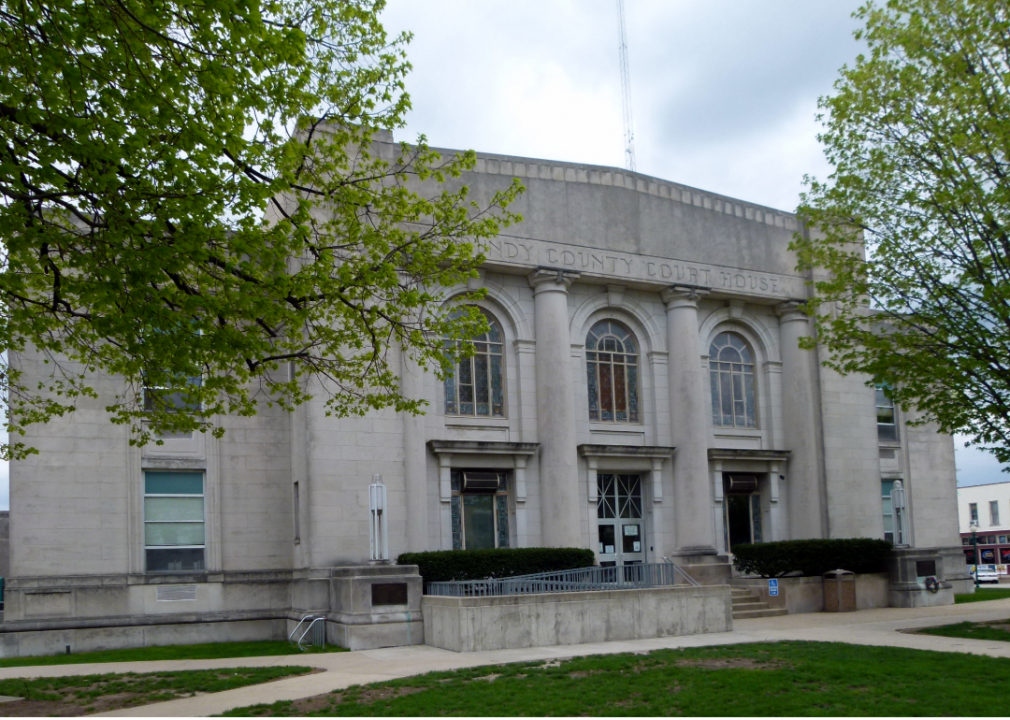Illinois
Illinois public officials seek greater oversight of prescription drug 'middlemen'

SPRINGFIELD, Ill. — As state lawmakers hold hearings targeting the role of pharmacy benefit managers – an influential arm in how the health insurance industry prices prescription drugs – multiple state agencies are considering how to better regulate the industry.
Often referred to as pharmaceutical “middlemen,” PBMs act as third-party intermediaries who negotiate the availability and price insurance companies or pharmacies pay for prescription drugs from pharmaceutical manufacturers. In determining the drugs covered by a given employer insurance plan, the companies can ultimately dictate what drugs are available to patients and pharmacies alike.
PBMs have received growing scrutiny on both a state and national level for the effect many claim they have on driving up drug prices. Local pharmacy owners testified at recent committee hearings that they are being squeezed by PBMs through the price of acquiring drugs wholesale and dispensing them, often at no profit or even at a loss. Over 40 percent of local pharmacies in Illinois – about 300 locations – have closed since 2013, according to the National Community Pharmacists Association.
“On almost every brand name medication that you fill, you lose money,” Michelle Dyer, pharmacist and owner of Michelle’s Pharmacy in Macoupin County, told the House Health Care Availability and Access Committee this week.
It was one of multiple recent hearings on the companies, and it followed last week’s review of a scathing audit of the state’s oversight of the industry. In part, the audit from 2023 found state regulators had scant documentation required for effective oversight of PBMs.
Joe Butcher, of the auditor general’s office, told lawmakers on the Legislative Audit Commission that the Illinois Department of Healthcare and Family Services failed to collect documents relevant to state Medicaid spending, which it is responsible for overseeing. Without necessary documents, Butcher said, the state cannot adequately exercise oversight authority.
“HFS was not engaging in monitoring practices of PBMs as mandated by the Illinois Public Aid Code, which establishes several provisions for monitoring PBMs,” he said.
HFS Director Elizabeth Whitehorn, who was appointed in January, said she was not sure how HFS failed to obtain documentation from entities under its watch.
“I don’t want to speak for what the department did or did not do before I was here,” she said. “I don’t know if the department ever asked for the contracts and they were not provided, or if the department simply didn’t ask for them.”
Whitehorn told lawmakers the department will soon file a new rule to help the department supervise PBMs, in part by requiring PBMs to divulge more information about their potential conflicts of interest. That will kick off a rulemaking process through which the department plans to submit the rule by June to the Joint Committee on Administrative Rules.
Corporate consolidation
Many PBMs, part of an industry that launched in the 1960s as prescription drugs became a consistent part of health plans, started as independent companies but were purchased by drug manufacturers in the 1990s.
Three publicly traded PBMs – CVS Caremark, Express Scripts and Optum RX – control about 80 percent of the U.S. PBM market, and the top six companies have over 95 percent, according to the Journal of the American Medical Association.
The state’s newly appointed insurance director, meanwhile, indicated her willingness to help regulate the industry, citing the consolidation of ownership as detrimental to patients. Ann Gillespie, a former CVS Caremark employee, was elevated to insurance director from the Illinois Senate by Gov. JB Pritzker last month.
“Corporate consolidation has exacerbated the situation, turning the existence of independent pharmacies from just a competitive market issue into a health care access issue,” Gillespie said at the House committee hearing Tuesday.
Gillespie also said the Department of Insurance is willing to “design and implement additional regulatory tools” with the General Assembly.
“PBMs have continually sought to evade scrutiny and accountability,” she said. “As legislators and regulators across the country have sought greater transparency, PBMs have also challenged state regulatory authority in the courts, creating additional barriers to stall regulatory efforts.”
Attendees at recent committee hearings referenced House Bill 4548, which aims to change Illinois’ insurance law so state government can better regulate PBMs. Proposed changes include having PBMs disclose the net cost of drugs covered by a health benefit plan, and restricting PBMs from ushering patients toward using pharmacies owned by associated companies.
Last year’s audit recommended consistent monitoring of PBMs, including requiring an annual report, which is outlined in HB 4548. The bill also outlines measures requiring PBMs to pay pharmacies a dispensing fee and reimburse them at a rate equal to the national average drug acquisition cost dictated by Medicaid.
The bill remains in a procedural committee in the House, making it unlikely to pass by the General Assembly’s end-of-May adjournment.
The Federal Trade Commission is also in the midst of an ongoing antitrust probe of six of the largest PBMs, five of which are owned by insurance companies themselves. Last year, the FTC withdrew prior statements of support for PBMs. And at a White House event in March, FTC chair Lina Khan said companies are not cooperating with the probe.
CVS Health, which has the largest share of the market, disputed the claim, according to news reports; but Rep. Natalie Manley, a Joliet Democrat who chairs the Illinois House committee that’s probing PBMs, criticized the lack of attendance by PBM executives at her committee’s first hearing on the industry last month.
“If there were 10 people here from the PBMs, I would put them right here and give you some backup,” Manley told a lobbyist from the Pharmaceutical Care Management Association, a national trade association representing a vast majority of PBMs.
“We need these questions answered, I’m not sure why they’re not here,” she added. “This was their opportunity to answer some of the accusations that are being lobbed at them.”
Only one PBM lobbyist and the president of Vivid Clear RX, a PBM subsidiary of Hy-Vee supermarkets, joined last month’s House committee hearing. One employee from the Blue Cross Blue Shield-owned PBM Prime Therapeutics also eventually testified.
The number of PBMs represented increased at this week’s hearing as another Prime Therapeutics representative and general counsel from Express Scripts joined a trade association lobbyist.
Jennifer Halsey, professor and director of ambulatory pharmacy services at the University of Illinois Chicago, said at last month’s hearing insurance companies are making billions while people in need are unsure if they can afford their prescriptions.
“We continue to see that insurance companies and PBMs make billions of dollars in profit alone every single year, and those profits increase year after year,” Halsey said. “I understand they have shareholders, but how do we make sure that patients have access to care? If we don’t get to the point where the pharmacies are being reimbursed at a reasonable rate, there will no longer be pharmacies for patients to go to.”
Manley said she expects “many more months” of hearings regarding PBMs.
Capitol News Illinois is a nonprofit, nonpartisan news service covering state government. It is distributed to hundreds of newspapers, radio and TV stations statewide. It is funded primarily by the Illinois Press Foundation and the Robert R. McCormick Foundation, along with major contributions from the Illinois Broadcasters Foundation and Southern Illinois Editorial Association.

Illinois
Counties with the highest unemployment in Illinois

Canva
#50. Williamson County
– April unemployment rate (preliminary): 4.3%
— 1-month change: Down 0.5 percentage points
— 1-year change: Up 0.4 percentage points
– Total labor force: 31,320 people (1,357 unemployed)

Henryk Sadura // Shutterstock
#49. Tazewell County
– April unemployment rate (preliminary): 4.3%
— 1-month change: Down 0.6 percentage points
— 1-year change: Up 0.3 percentage points
– Total labor force: 61,017 people (2,644 unemployed)

Canva
#48. Will County
– April unemployment rate (preliminary): 4.3%
— 1-month change: Down 0.7 percentage points
— 1-year change: Up 0.9 percentage points
– Total labor force: 373,554 people (16,060 unemployed)

Canva
#47. St. Clair County
– April unemployment rate (preliminary): 4.4%
— 1-month change: Down 0.4 percentage points
— 1-year change: Up 0.3 percentage points
– Total labor force: 124,884 people (5,535 unemployed)

Canva
#46. Saline County
– April unemployment rate (preliminary): 4.5%
— 1-month change: Down 0.4 percentage points
— 1-year change: Up 0.2 percentage points
– Total labor force: 9,756 people (438 unemployed)

Canva
#45. Montgomery County
– April unemployment rate (preliminary): 4.5%
— 1-month change: Down 0.9 percentage points
— 1-year change: Down 0.3 percentage points
– Total labor force: 11,307 people (512 unemployed)

Canva
#44. Christian County
– April unemployment rate (preliminary): 4.5%
— 1-month change: Down 0.6 percentage points
— 1-year change: No change
– Total labor force: 13,290 people (603 unemployed)

Canva
#43. Marion County
– April unemployment rate (preliminary): 4.5%
— 1-month change: Down 0.4 percentage points
— 1-year change: Up 0.4 percentage points
– Total labor force: 16,524 people (744 unemployed)

Canva
#42. Grundy County
– April unemployment rate (preliminary): 4.5%
— 1-month change: Down 0.9 percentage points
— 1-year change: Up 0.9 percentage points
– Total labor force: 26,611 people (1,191 unemployed)

Canva
#41. Whiteside County
– April unemployment rate (preliminary): 4.5%
— 1-month change: Down 0.8 percentage points
— 1-year change: Up 0.5 percentage points
– Total labor force: 27,301 people (1,236 unemployed)

Canva
#40. DeKalb County
– April unemployment rate (preliminary): 4.5%
— 1-month change: Down 0.6 percentage points
— 1-year change: Up 0.3 percentage points
– Total labor force: 53,982 people (2,455 unemployed)

Canva
#39. Cook County
– April unemployment rate (preliminary): 4.5%
— 1-month change: Down 0.4 percentage points
— 1-year change: Up 0.9 percentage points
– Total labor force: 2.7 million people (119,860 unemployed)

Roberto Galan // Shutterstock
#38. Massac County
– April unemployment rate (preliminary): 4.6%
— 1-month change: Down 0.2 percentage points
— 1-year change: Up 0.3 percentage points
– Total labor force: 5,342 people (247 unemployed)

Canva
#37. Mason County
– April unemployment rate (preliminary): 4.6%
— 1-month change: Down 0.6 percentage points
— 1-year change: No change
– Total labor force: 5,920 people (271 unemployed)

Eddie J. Rodriquez // Shutterstock
#36. Carroll County
– April unemployment rate (preliminary): 4.6%
— 1-month change: Down 1.1 percentage points
— 1-year change: Up 0.7 percentage points
– Total labor force: 7,075 people (324 unemployed)

Canva
#35. Fayette County
– April unemployment rate (preliminary): 4.6%
— 1-month change: Down 0.7 percentage points
— 1-year change: Down 0.1 percentage points
– Total labor force: 9,586 people (444 unemployed)

Canva
#34. Iroquois County
– April unemployment rate (preliminary): 4.6%
— 1-month change: Down 1.0 percentage points
— 1-year change: Up 0.4 percentage points
– Total labor force: 12,910 people (597 unemployed)

Canva
#33. Logan County
– April unemployment rate (preliminary): 4.7%
— 1-month change: Down 0.6 percentage points
— 1-year change: Up 0.5 percentage points
– Total labor force: 11,283 people (532 unemployed)

Eddie J. Rodriquez // Shutterstock
#32. Marshall County
– April unemployment rate (preliminary): 4.8%
— 1-month change: Down 0.8 percentage points
— 1-year change: Up 0.1 percentage points
– Total labor force: 5,061 people (242 unemployed)

SevenMaps // Shutterstock
#31. Perry County
– April unemployment rate (preliminary): 4.8%
— 1-month change: Down 0.6 percentage points
— 1-year change: Up 0.2 percentage points
– Total labor force: 7,663 people (370 unemployed)

Canva
#30. Stephenson County
– April unemployment rate (preliminary): 4.8%
— 1-month change: Down 0.8 percentage points
— 1-year change: Up 0.2 percentage points
– Total labor force: 20,948 people (1,012 unemployed)

Gregory S. King // Shutterstock
#29. Scott County
– April unemployment rate (preliminary): 4.9%
— 1-month change: Down 0.9 percentage points
— 1-year change: Down 0.1 percentage points
– Total labor force: 2,267 people (112 unemployed)

Canva
#28. Fulton County
– April unemployment rate (preliminary): 4.9%
— 1-month change: Down 0.9 percentage points
— 1-year change: Down 0.1 percentage points
– Total labor force: 14,527 people (718 unemployed)

Canva
#27. Gallatin County
– April unemployment rate (preliminary): 5.0%
— 1-month change: Up 0.2 percentage points
— 1-year change: Up 0.6 percentage points
– Total labor force: 2,048 people (103 unemployed)

Canva
#26. Union County
– April unemployment rate (preliminary): 5.0%
— 1-month change: Down 0.8 percentage points
— 1-year change: Up 0.3 percentage points
– Total labor force: 7,110 people (354 unemployed)

Canva
#25. Clay County
– April unemployment rate (preliminary): 5.1%
— 1-month change: Down 0.5 percentage points
— 1-year change: Up 0.5 percentage points
– Total labor force: 5,756 people (294 unemployed)

Kent Raney // Shutterstock
#24. Rock Island County
– April unemployment rate (preliminary): 5.1%
— 1-month change: Down 0.5 percentage points
— 1-year change: Up 0.8 percentage points
– Total labor force: 65,829 people (3,388 unemployed)

Canva
#23. Lake County
– April unemployment rate (preliminary): 5.1%
— 1-month change: Down 1.1 percentage points
— 1-year change: Up 0.4 percentage points
– Total labor force: 361,863 people (18,529 unemployed)

Canva
#22. Clark County
– April unemployment rate (preliminary): 5.2%
— 1-month change: Down 0.5 percentage points
— 1-year change: Up 1.3 percentage points
– Total labor force: 7,256 people (376 unemployed)

Canva
#21. Henry County
– April unemployment rate (preliminary): 5.2%
— 1-month change: Down 0.4 percentage points
— 1-year change: Up 0.7 percentage points
– Total labor force: 23,265 people (1,201 unemployed)

Canva
#20. Putnam County
– April unemployment rate (preliminary): 5.3%
— 1-month change: Down 1.5 percentage points
— 1-year change: Up 0.5 percentage points
– Total labor force: 2,952 people (157 unemployed)

marythebarberphotos // Shutterstock
#19. Franklin County
– April unemployment rate (preliminary): 5.3%
— 1-month change: Down 0.5 percentage points
— 1-year change: Up 0.6 percentage points
– Total labor force: 15,862 people (839 unemployed)

Roberto Galan // Shutterstock
#18. Vermilion County
– April unemployment rate (preliminary): 5.3%
— 1-month change: Down 0.4 percentage points
— 1-year change: Up 0.2 percentage points
– Total labor force: 31,702 people (1,678 unemployed)

Canva
#17. Kane County
– April unemployment rate (preliminary): 5.3%
— 1-month change: Down 1.0 percentage points
— 1-year change: Up 0.6 percentage points
– Total labor force: 266,000 people (14,041 unemployed)

Roberto Galan // Shutterstock
#16. Johnson County
– April unemployment rate (preliminary): 5.4%
— 1-month change: Down 0.6 percentage points
— 1-year change: Up 0.5 percentage points
– Total labor force: 4,223 people (229 unemployed)

Canva
#15. Lawrence County
– April unemployment rate (preliminary): 5.4%
— 1-month change: Down 0.6 percentage points
— 1-year change: Up 0.9 percentage points
– Total labor force: 4,947 people (265 unemployed)

Canva
#14. Ogle County
– April unemployment rate (preliminary): 5.4%
— 1-month change: Down 0.7 percentage points
— 1-year change: Up 0.1 percentage points
– Total labor force: 23,847 people (1,284 unemployed)

Canva
#13. Hardin County
– April unemployment rate (preliminary): 5.5%
— 1-month change: Up 0.1 percentage points
— 1-year change: Up 0.6 percentage points
– Total labor force: 1,436 people (79 unemployed)

Caileb Feik // Shutterstock
#12. Mercer County
– April unemployment rate (preliminary): 5.5%
— 1-month change: Down 0.5 percentage points
— 1-year change: Up 1.4 percentage points
– Total labor force: 7,478 people (413 unemployed)

Canva
#11. Stark County
– April unemployment rate (preliminary): 5.6%
— 1-month change: Down 0.8 percentage points
— 1-year change: Up 0.7 percentage points
– Total labor force: 2,384 people (133 unemployed)

Canva
#10. Knox County
– April unemployment rate (preliminary): 5.6%
— 1-month change: Down 0.4 percentage points
— 1-year change: Up 0.6 percentage points
– Total labor force: 20,151 people (1,130 unemployed)

Canva
#9. Peoria County
– April unemployment rate (preliminary): 5.6%
— 1-month change: Down 0.5 percentage points
— 1-year change: Up 0.5 percentage points
– Total labor force: 81,294 people (4,528 unemployed)

Canva
#8. Macon County
– April unemployment rate (preliminary): 5.7%
— 1-month change: Down 0.5 percentage points
— 1-year change: Up 0.1 percentage points
– Total labor force: 43,982 people (2,496 unemployed)

Canva
#7. Kankakee County
– April unemployment rate (preliminary): 5.7%
— 1-month change: Down 0.7 percentage points
— 1-year change: Up 0.3 percentage points
– Total labor force: 51,466 people (2,932 unemployed)

Canva
#6. LaSalle County
– April unemployment rate (preliminary): 5.8%
— 1-month change: Down 0.8 percentage points
— 1-year change: Up 0.6 percentage points
– Total labor force: 50,861 people (2,959 unemployed)

Canva
#5. Winnebago County
– April unemployment rate (preliminary): 5.8%
— 1-month change: Down 0.6 percentage points
— 1-year change: Down 0.3 percentage points
– Total labor force: 129,475 people (7,514 unemployed)

Canva
#4. Bureau County
– April unemployment rate (preliminary): 5.9%
— 1-month change: Down 1.0 percentage points
— 1-year change: Up 1.3 percentage points
– Total labor force: 15,506 people (922 unemployed)

Roberto Galan // Shutterstock
#3. Alexander County
– April unemployment rate (preliminary): 6.0%
— 1-month change: Down 0.1 percentage points
— 1-year change: Up 0.8 percentage points
– Total labor force: 1,815 people (108 unemployed)

JL Jahn // Shutterstock
#2. Boone County
– April unemployment rate (preliminary): 6.4%
— 1-month change: Down 1.5 percentage points
— 1-year change: Down 0.7 percentage points
– Total labor force: 24,413 people (1,569 unemployed)

Hank Shiffman // Shutterstock
#1. Pulaski County
– April unemployment rate (preliminary): 7.8%
— 1-month change: Up 0.9 percentage points
— 1-year change: Up 1.2 percentage points
– Total labor force: 1,631 people (127 unemployed)
This story features data reporting by Paxtyn Merten and is part of a series utilizing data automation across 50 states.
Illinois
Trump Guilty Verdict Local Reactions: Illinois Readers Weigh In

ILLINOIS — On Thursday, a jury in New York convicted former President Donald J. Trump on 34 felony counts in his criminal hush money trial.
It’s the first-ever criminal case against a former U.S. president, and even as Trump still faces charges in three other cases, his sentencing in the hush money case is scheduled for July 11 — just four days before he’s set to officially become the nominee for president at the Republican National Convention.
While Trump’s conviction means he could be sentenced to anything from home confinement to probation to up to four years in prison, he is still eligible to run for president in 2024, and, as multiple outlets have noted, the former president will almost certainly file an appeal.
Patch wants to know — how do voters in Illinois feel? Take our survey below to let us know.
The survey is not scientific, but will give a general gauge of how Illinois Patch readers feel going into the 2024 presidential election. We will share the results in a follow up story.
Illinois
Springfield, Illinois Chuck E. Cheese location to retain animatronic band

CHICAGO (CBS) — A Chuck E. Cheese in downstate Illinois will be one of the select few to retain an animatronic band.
In November, Chuck E. Cheese announced that it would be pulling the plug on the animatronic performances at all locations but one in the Northridge neighborhood of Los Angeles – where the company said Munch’s Make-Believe Band, as it’s known, would retain a “permanent residency.”
Chuck E. Cheese also said another location in Nanuet, New York, in Rockland County north of New York City, would retain the animatronic band—and remain a “100% retro store,” according to published reports.
But that was to be it.
In recent days, however, Chuck E. Cheese announced that three more locations would be keeping the robot band—including one at the Town & Country Shopping Center at 2369 S. MacArthur Blvd. in Springfield, the state capital. Also on the list to keep the band are Chuck E. Cheese in Hicksville, Long Island, New York, and Charlotte, North Carolina.
Earlier this month, Chuck E. Cheese President and Chief Executive Officer David McKillips told CBS News the company needed to keep up with the times and the interests of today’s kids. Thus, the animatronic band was on its way out, while trampoline zones, and floor-to-ceiling Jumbotrons overlooking digital dance floors, were on their way in.
“This is the most exciting time in the brand’s 47-year history,” McKillips told CBS News. “It’s a complete brand transformation here at Chuck E. Cheese.”
Active play areas are a major priority, McKillips said.
“Most importantly for mom, it’s bright, it’s clean, and now we’ve embraced active play installing trampolines in every single one of our locations coast to coast,” McKillips told CBS News.
He added that while Chuck E. Cheese has an “incredible legacy of bands,” it remains the reality that “like any other great brand, you have to evolve.”
Chuck E. Cheese has a grand total of 19 locations in Illinois, including two in Chicago—one in the Riverpoint Shopping Center at 1830 W. Fullerton Ave. along the Chicago River’s North Branch, the other at 5030 S. Kedzie Ave. in Gage Park. There are also 12 suburban locations, and five more either downstate or elsewhere in Northern Illinois. Chuck E. Cheese also has a location in Merrillville, Indiana.
Chuck E. Cheese and its animatronics date back over 40 years in Chicago, once had competition
Chuck E. Cheese was founded in 1977 by Atari’s co-founder, Nolan Bushnell, with the first location opening as Chuck E. Cheese’s Pizza Time Theatre in San Jose, California. It was the first family restaurant to marry food with arcade games and animated entertainment.
Chuck E. Cheese’s Pizza Time Theatre arrived in Illinois in 1981, with a location in Loves Park near Rockford. A Chicago location opened a couple of years later at the Harlem-Foster Shopping Center, at 7300 W. Foster Ave. on the city’s Northwest Side.
By contrast to today’s brightly-lit spaces, Chuck E. Cheese’s Pizza Time Theatre back in the 1980s was composed of so many massive, dimly-lit rooms with arcade games, mini-carnival rides, Skee-Ball and Whac-A-Mole, ball pits, and mazes with rope ladders to climb.
The Foster Avenue location featured three different rooms of animatronic musical acts. A main dining room featuring the Pizza Time Players—Jasper T. Jowls, Helen Henny, Pasqually, Mr. Munch, and of course Chuck E. Cheese himself—who back then was depicted as a wisecracking rat with a New Jersey accent and attire that to some suggested a casino pit boss, rather than today’s mouse in a skateboarder outfit. Other party rooms featured a band of dogs called “The Beagles,” and a lion in a white and gold jumpsuit called “The King”—which mimed along to real recordings of The Beatles and Elvis Presley, respectively. A fourth animatronic act, jazz-singing hippo Dolli Dimples, was the first sight seen upon entering the amusement venue.
An April 1983 Chicago Tribune article held up Chuck E. Cheese as one of a few operations capitalizing on a trend of offering pizza, video games, and other family-friendly entertainment under one roof.
“Combination pizza restaurant/video game parlors have invaded the Chicago area like locusts in the last few months,” writer Richard Phillips wrote in the article. “By summer’s end, their number may well be doubled.”
Chuck E. Cheese’s main competitor at the time was ShowBiz Pizza Place—which at the time had just opened a location in Park Ridge as its fifth in the Chicago suburbs. ShowBiz had its own animatronic band known as the Rock-afire Explosion, fronted by a bear character called Billy Bob Brockali.
The article also highlighted a third operation that was strictly local—ShowTime America, previously and subsequently known as Sally’s Stage, at 6335 N. Western Ave. across from the Nortown movie theater in West Rogers Park. Sally’s Stage did not have any animatronics—it was famous for its Barton theater pipe organ and hostesses on a roller skate track. But Phillips’ article did note that as of April 1983—while under the ShowTime America name—Sally’s did feature free video games for patrons and “Roger, a remote-control robot, who [when functional] impresses kids with questions and dispenses free tickets for sundaes.”
Of these, only Chuck E. Cheese remains—and not the one on Foster Avenue, which later became a Little Ceasar’s Caesarland and is now a Planet Fitness gym. ShowBiz and Chuck E. Cheese merged after Chuck E. Cheese’s Pizza Time Theatre filed for bankruptcy in 1984—and while they went on as separate concepts for a while, the Chuck E. Cheese name had prevailed for the whole operation by the early 90s. The site where Sally’s Stage once stood is now occupied by a Hanmi Bank.
As of August of last year, Chuck E. Cheese operated 568 corporate and franchised locations, as well as 122 Peter Piper Pizza restaurants.
-

 News1 week ago
News1 week agoThe states where abortion is on the ballot in November : Consider This from NPR
-

 News1 week ago
News1 week agoRead Prosecutors’ Filing on Mar-a-Lago Evidence in Trump Documents Case
-

 World1 week ago
World1 week agoSerbian parliamentary minnow pushes for 'Russian law' equivalent
-

 Politics1 week ago
Politics1 week agoMichael Cohen swore he had nothing derogatory on Trump, his ex-lawyer says – another lie – as testimony ends
-

 News1 week ago
News1 week agoVince Fong wins special election to finish term of former House Speaker Kevin McCarthy
-

 World1 week ago
World1 week ago€440k frozen in Italy over suspect scam by fake farmers
-

 News1 week ago
News1 week agoVideo: Midwest Storms Destroy Homes
-

 News1 week ago
News1 week agoBuy-now, pay-later returns and disputes are about to get federal oversight














